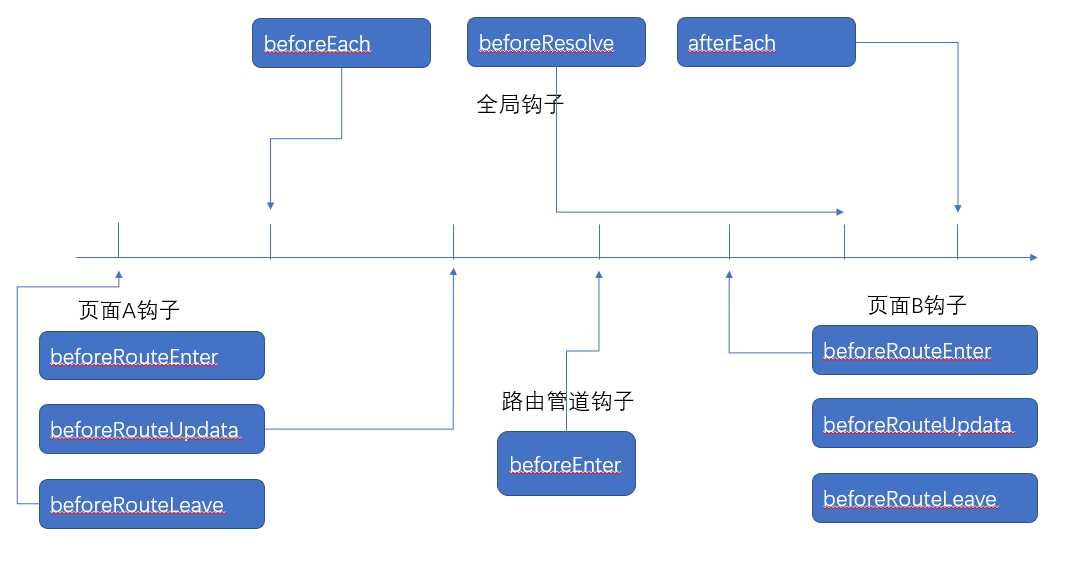标签:获取 back before vue false ffffff || 效果 ejs
1、导航守卫钩子
导航守卫的用途主要是在用户离开页面前提醒用户,和页面访问前先登录。共有7个钩子,其中全局钩子有3个,组件钩子有3个,路由管道钩子有1个。
全局钩子:
const router = new VueRouter({ ... }) router.beforeEach((to, from, next) => { // ...(2) //全局前置守卫 }) router.beforeResolve((to, from, next) => { // ...(6) //全局解析守卫 }) router.afterEach((to, from) => { // ...(7) //全局后置守卫 }
组件内的钩子:
export default { data(){}, beforeRouteEnter (to, from, next) { //....(5) // 在渲染该组件的对应路由被 confirm 前调用 // 不!能!获取组件实例 `this` // 因为当守卫执行前,组件实例还没被创建 }, beforeRouteUpdate (to, from, next) { // ... (3) // 在当前路由改变,但是该组件被复用时调用 // 举例来说,对于一个带有动态参数的路径 /foo/:id,在 /foo/1 和 /foo/2 之间跳转的时候, // 由于会渲染同样的 Foo 组件,因此组件实例会被复用。而这个钩子就会在这个情况下被调用。 // 可以访问组件实例 `this` }, beforeRouteLeave (to, from, next) { // ... (1) // 导航离开该组件的对应路由时调用 // 可以访问组件实例 `this` } }
路由管道钩子:
const router = new VueRouter({ routes: [ { path: ‘/foo‘, component: Foo, beforeEnter: (to, from, next) => { // ...(4) } } ] })
2、参数解析
每个守卫方法接收三个参数:
to: Route: 即将要进入的目标 路由对象,该对象有目标页的路由信息。
from: Route: 当前导航正要离开的路由,该对象有当前页的路由信息。
next: Function: 一定要调用该方法来 resolve 这个钩子。执行效果依赖 next 方法的调用参数。
next(): 进行管道中的下一个钩子。如果全部钩子执行完了,则导航的状态就是 confirmed (确认的)。
next(false): 中断当前的导航。如果浏览器的 URL 改变了 (可能是用户手动或者浏览器后退按钮),那么 URL 地址会重置到 from 路由对应的地址。
next(‘/‘) 或者 next({ path: ‘/‘ }): 跳转到一个不同的地址。当前的导航被中断,然后进行一个新的导航。你可以向 next 传递任意位置对象,且允许设置诸如 replace: true、name: ‘home‘ 之类的选项以及任何用在 router-link 的 to prop 或 router.push 中的选项。
next(error): (2.4.0+) 如果传入 next 的参数是一个 Error 实例,则导航会被终止且该错误会被传递给 router.onError() 注册过的回调。
确保要调用 next 方法,否则钩子就不会被 resolved。
3、导航流程
beforeEach 守卫。beforeRouteUpdate 守卫 (2.2+)。beforeEnter。beforeRouteEnter。beforeResolve 守卫 (2.5+)。afterEach 钩子。beforeRouteEnter 守卫中传给 next 的回调函数。4、导航流程图(页面切换的执行顺序)

5、页面跳转前需登录 - 实验
1)首先需要给isLogin为false,表示未登录,将该值初始在store内,
export default new Vuex.Store({ state: { isLogin: false, }, mutations: { handleLogin(state, login) { state.isLogin = login; }, }, });
2)在登录页- 登录按钮 设置点击时修改store内的isLogin为true,同时跳转到首页‘/home’
methods: { ...mapMutations([‘handleLogin‘]), handleSubmit() { // 修改store里的isLogin为true,表示登录了 this.handleLogin(true) this.$router.push({path: ‘/home‘}) } }
3)每一次页面切换时,全局钩子beforeEach都会触发,在该钩子内判断 是否登录了?若没有登录,需要跳转到 登录页 ‘/login’,否则 可以跳转
router.beforeEach((to, from, next) => { const isLogin = obj.state.isLogin; if (to.path === ‘/login‘ || isLogin) { next(); } else { next(‘/login‘); } });
6、参考文献
https://www.cnblogs.com/minigrasshopper/p/7928311.html
route
标签:获取 back before vue false ffffff || 效果 ejs
原文地址:https://www.cnblogs.com/Ladai/p/11721177.html